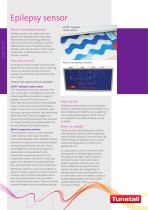
Catalog excerpts

Epilepsy sensor Data Sheet What is an epilepsy sensor? Emfit™ epileptic seizure alarm Epilepsy sensors are used to monitor people with epilepsy while they sleep. Patented sensor technology detects a person’s movement in bed and is able to differentiate normal movements from epileptic seizures. An alarm can be raised using either a Lifeline home unit or via Telecare Overlay. How does it work? An epilepsy sensor enables seizures to be detected the moment they occur, ensuring carers can respond quickly if they are needed, but otherwise do not disturb the user’s sleep. Alert-It companion monitor There are two types of sensor available: Emfit™ epileptic seizure alarm This state of the art sensor monitors the user's vital signs including heart rate and breathing patterns to detect a range of epileptic seizures. The bed sensor is extremely thin and contains no embedded wires or switches. It should be installed under a foam mattress or mattress cover (if using a sprung mattress), and positioned below the chest. The alarm triggers if it senses movements associated with a seizure for longer than the pre-set delay, which can be set to between 10 and 20 seconds. Alert-It companion monitor The companion monitor uses a discreet under-mattress bed sensor to detect movement together with a bedside monitor unit with an optional microphone to detect sounds associated with seizures. These work together to sense various types of seizure and can be adjusted to the individual’s unique requirements. The Companion sensor will work on most bed types and mattresses including profiling bed, memory foam and air flow mattresses. Whichever sensor is used, once it detects a seizure it sends a signal to a small interface module, which can be positioned under a bed, to provide wireless communication with a Lifeline home unit or Telecare Overlay system to enable care to be delivered quickly. Who is it for? Epilepsy sensors can be used in individual homes or assisted living environments. They are portable and simple to use, supporting carers and protecting users. Both sensors are suitable for use with children as well as adults. Why is it needed? There are over 600,000 people in the UK with epilepsy. Defined as the tendency to have recurrent seizures, there are about 40 different types of epilepsy and it is most commonly diagnosed in children and people over 65. In many cases a carer for someone with epilepsy will undertake regular checks throughout the night, which is labour intensive for paid carers and means broken sleep for informal carers. The person affected may also find these checks intrusive and undignified. An epilepsy sensor will automatically raise an alert with a carer if it detects a seizure, enabling appropriate care be provided quickly, without the need for manual checks.
Open the catalog to page 1
Features and benefits • Patented sensor technology - reduces number of false calls • Transmission to Class One receiver ensuring alarms are reliably received • Sensitivity adjustment - enables the adjustment of the sensor to the individual’s requirements • Operates on the dedicated social alarm frequency - for reliable future proof operation • Unobtrusive - minimises user disruption • Compatible with Lifeline home units and other Tunstall telecare enabled systems • Plug and play registration - eases programming • Automatic radio trigger low battery warning - ensures optimum operation...
Open the catalog to page 2All Tunstall catalogs and technical brochures
-
Ambient Temperature Sensor
2 Pages
-
Lifeline GSM
4 Pages
-
Smart Hub
6 Pages
-
Dementia Care
16 Pages
-
Lifeline Vi and Vi+
8 Pages
-
Tunstall LifeCare
2 Pages
-
Innovations
23 Pages
-
Falls management
4 Pages
-
Total Housing Solutions brochure
16 Pages
-
Housing Services Portal
9 Pages
-
mymedic II
2 Pages
-
Bed Occupancy Sensor
2 Pages
-
Communicall Vi
8 Pages
-
iVi Intelligent Pendant
4 Pages
-
myclinic
4 Pages
-
Lifeline Vi
6 Pages
-
Portfolio Issue 25
48 Pages
-
CareAssist
2 Pages
-
Lifeline Vi
8 Pages






















